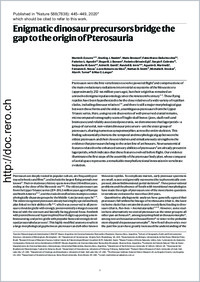Enigmatic dinosaur precursors bridge the gap to the origin of Pterosauria
- Ezcurra, Martín D. Sección Paleontología de Vertebrados CONICET–Museo Argentino de Ciencias Naturales ‘Bernardino Rivadavia‘, Buenos Aires, Argentina - School of Geography, Earth and Environmental Sciences, University of Birmingham, Birmingham, UK
- Nesbitt, Sterling J. Department of Geosciences, Virginia Tech, Blacksburg, VA, USA
- Bronzati, Mario Departamento de Biologia, Universidade de São Paulo, Ribeirão Preto, Brazil
- Vecchia, Fabio Marco Dalla Research Group of Mesozoic Faunas, Institut Català de Paleontologia Miquel Crusafont (ICP), Sabadell, Spain - Museo Friulano di Storia Naturale, Udine, Italy
- Agnolin, Federico L. Laboratorio de Anatomía Comparada y Evolución de los Vertebrados CONICET–Museo Argentino de Ciencias Naturales ‘Bernardino Rivadavia’, Buenos Aires, Argentina - Fundación de Historia Natural ‘Félix de Azara’, Departamento de Ciencias Naturales y Antropología, Universidad Maimónides, Buenos Aires, Argentina
- Benson, Roger B. J. Department of Earth Sciences, University of Oxford, Oxford, UK
- Egli, Federico Brissón Laboratorio de Anatomía Comparada y Evolución de los Vertebrados CONICET–Museo Argentino de Ciencias Naturales ‘Bernardino Rivadavia’, Buenos Aires, Argentina
- Cabreira, Sergio F. Associação Sul Brasileira de Paleontologia, Faxinal do Soturno, Brazil
- Evers, Serjoscha W. Department of Earth Sciences, University of Oxford, Oxford, UK - Department of Geosciences, University of Fribourg, Fribourg, Switzerland
- Gentil, Adriel R. Laboratorio de Anatomía Comparada y Evolución de los Vertebrados CONICET–Museo Argentino de Ciencias Naturales ‘Bernardino Rivadavia’, Buenos Aires, Argentina
- Irmis, Randall B. Natural History Museum of Utah, University of Utah, Salt Lake City, UT, USA - Department of Geology and Geophysics, University of Utah, Salt Lake City, UT, USA
- Martinelli, Agustín G. Sección Paleontología de Vertebrados CONICET–Museo Argentino de Ciencias Naturales ‘Bernardino Rivadavia‘, Buenos Aires, Argentina
- Novas, Fernando E. Laboratorio de Anatomía Comparada y Evolución de los Vertebrados CONICET–Museo Argentino de Ciencias Naturales ‘Bernardino Rivadavia’, Buenos Aires, Argentina
- Silva, Lúcio Roberto da Associação Sul Brasileira de Paleontologia, Faxinal do Soturno, Brazil
- Smith, Nathan D. The Dinosaur Institute, Natural History Museum of Los Angeles County, Los Angeles, CA, USA
- Stocker, Michelle R. Department of Geosciences, Virginia Tech, Blacksburg, VA, USA
- Turner, Alan H. Department of Anatomical Sciences, Stony Brook University, Stony Brook, NY, USA
- Langer, Max C. Departamento de Biologia, Universidade de São Paulo, Ribeirão Preto, Brazil
-
09.12.2020
Published in:
- Nature. - 2020, vol. 588, no. 2020-7838, p. 445–449
English
Pterosaurs were the first vertebrates to evolve powered flight1 and comprised one of the main evolutionary radiations in terrestrial ecosystems of the Mesozoic era (approximately 252–66 million years ago), but their origin has remained an unresolved enigma in palaeontology since the nineteenth century2,3,4. These flying reptiles have been hypothesized to be the close relatives of a wide variety of reptilian clades, including dinosaur relatives2,3,4,5,6,7,8, and there is still a major morphological gap between those forms and the oldest, unambiguous pterosaurs from the Upper Triassic series. Here, using recent discoveries of well-preserved cranial remains, microcomputed tomography scans of fragile skull bones (jaws, skull roofs and braincases) and reliably associated postcrania, we demonstrate that lagerpetids—a group of cursorial, non-volant dinosaur precursors—are the sister group of pterosaurs, sharing numerous synapomorphies across the entire skeleton. This finding substantially shortens the temporal and morphological gap between the oldest pterosaurs and their closest relatives and simultaneously strengthens the evidence that pterosaurs belong to the avian line of archosaurs. Neuroanatomical features related to the enhanced sensory abilities of pterosaurs9 are already present in lagerpetids, which indicates that these features evolved before flight. Our evidence illuminates the first steps of the assembly of the pterosaur body plan, whose conquest of aerial space represents a remarkable morphofunctional innovation in vertebrate evolution.
- Faculty
- Faculté des sciences et de médecine
- Department
- Département de Géosciences
- Language
-
- English
- Classification
- Palaeontology
- License
-
License undefined
- Identifiers
-
- RERO DOC 329918
- DOI 10.1038/s41586-020-3011-4
- Persistent URL
- https://folia.unifr.ch/unifr/documents/309284
Statistics
Document views: 304
File downloads:
- pdf: 1544
